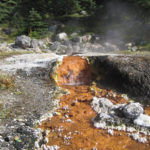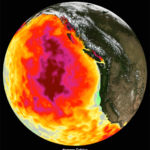Continuing explorations into a remote hot spring, deep within the British Columbia backcountry, researchers from the University of Calgary and the JGI employed single-cell sequencing to assess the diversity within and between microbial populations. The work, published in The ISME Journal, showed the value of conducting large-scale single cell genomics by collecting nearly 500 single cells from a single low diversity hot spring sediment sample. Their work showed that single cell genomics can add significant value to the other commonly used culture-independent sequencing approaches including amplicon and metagenomic sequencing. Learn more here on the JGI website.
JGI Enables Time-series Study of ‘The Blob’s’ Impact
Enabled by the JGI’s Community Science Program, a team led by University of British Columbia researchers tracked the impact of a large-scale heatwave event in the ocean known as “The Blob.” The microbial communities in the ocean drive the biological pump that takes carbon from the atmosphere and keeps it in the deep ocean. With genomic samples collected before, during and after The Blob, the researchers developed a preliminary model of how marine microbial communities are affected by warming events. They recently shared their findings in Communications Biology. The work underscores the value of large-scale research collaborations and of conducting even more time-series studies.
Learn more here on the JGI website.
JGI Helps Reveal Marine Microbe Contains Multitudes
The bacterium SAR324 is unusually cosmopolitan. In the ocean’s North Pacific Subtropical Gyre, microbes tend to stay localized at different depths. But SAR324 can be found throughout the water column, from the warm, well-lit surface, to the blue-lit twilight zone, to the continuous pressure of the dark abyss, 4000 m (2.5 miles) deep. Scientists have wondered, how can SAR324 exist in so many varied environments? Now, a recent study supported by JGI and has uncovered that SAR324 encompasses four subgroups, adapted to different oceanic depths and relying on different ways of living. Read more about the hidden diversity of SAR324 on the JGI website.
Tanja Woyke Appointed Division Deputy for JGI User Programs
Joint Genome Institute (JGI) Director Nigel Mouncey has announced that effective March 1 senior scientist Tanja Woyke is officially the Deputy for JGI User Programs. She had been serving in the position on an interim basis for the past nine months. Woyke will continue to lead the Microbial Program and will split her time equally between these important roles for JGI. JGI User Programs interact with scientists across the world who are interested in collaborating on projects relevant to DOE-related problems. The Microbial Program is one of JGI’s five science programs, and conducts high-impact science focused on terrestrial carbon cycling and plant-microbe interactions.
JGI Leads Large-Scale Effort to Develop a Genomic Catalog of Earth’s Microbiomes
Microorganisms play key roles in regulating global nutrient cycles but only a small fraction has been identified and an even smaller number has been successfully cultured in a lab for study. In Nature Biotechnology, the known diversity of bacteria and archaea has now expanded by 44% through a publicly available collection of more than 52,000 microbial genomes from environmental samples. Of that number, 70% of the novel genome sequences were previously unknown, not yet cultured in the lab. The work results from a JGI-led collaboration involving more than 200 scientists around the world, KBase and NERSC. Read more about the genomic catalog of Earth’s microbiomes on the JGI website.
Was this page useful?








